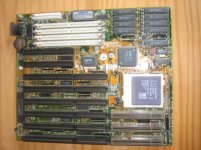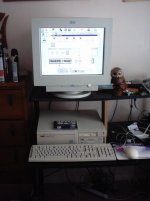 Hi Folks
Hi FolksI try to bring a M-Board back to live from which I assume it is a VL-M-Board: HOT-419DZ (REV 3)
The Problem is that way, that the board don't pass the Power On Self Test. I did insert an omni POST Card and it tells me Step 04 Postcode passed stop at 05 : "Soft reset / power on determined. Going to enable ROM i.e. disable shadow Ram if any.
but after removing D-Ram Simm from bank 0 and bank 1 the postcode stops at step #13
that encourage me to add a VL-Video Card and an ISA HDD/Fd Controller. Bank #0 was fitted with one Simm module only
I did power up again and the Post Code stops now at step # 4F
Now I changed the Simm and the post code was stopped at step # D0
changing the Simm again the POST Code now always stops at step #13.
does some Body have a clue what ther could be happend?
is that possible the the Bios does not fit the Main Board ?
How can I determine the Size of a Simm Module from the inscription of the Chips ?
Best Regards Joe

